7 Common Twitter Mistakes & How to Avoid Them
ADRIENNE WOLTER | 12 MAY 2016
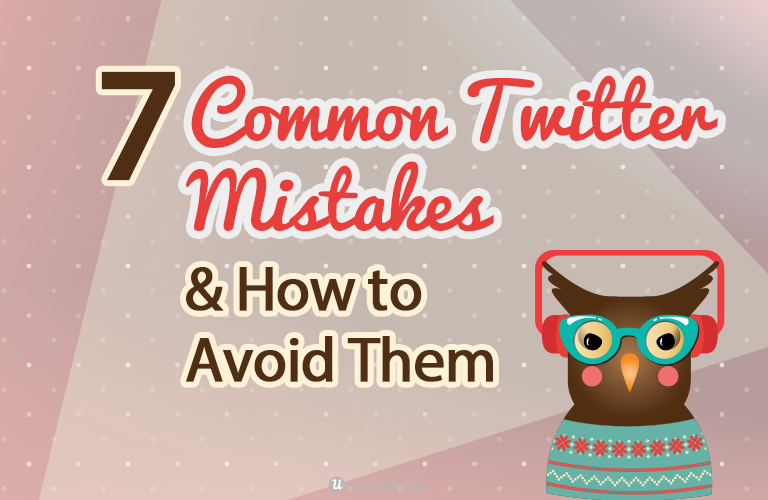
Twitter has been ubiquitous ever since its meteoric rise to popularity in 2009. Despite boasting over 320,000,000 monthly active users, this powerful micro-blogging platform still presents a bit of a learning curve to new users.
In fact, even people who have been using Twitter for years sometimes still make mistakes that negatively impact the reach and value of their tweets.
These mistakes are basic and all fairly common, but understanding what to avoid will ultimately help your tweets make it to a far broader audience, help you make connections you would have missed, and maybe even help your brand avoid an embarrassing faux pas.
Starting a Tweet with a @Mention
The at-sign on Twitter is used to create a “@mention,” which is just a way of referring to another Twitter user. The @mention becomes a link to the other user’s profile when your tweet is posted, and most users also get a notification when they are @mentioned in a tweet.
However, things work a little differently if you start a tweet with a @mention. It feels natural to start this way if you are talking about a person or a brand with a Twitter account, but doing this actually starts a conversation with that user. The tweet is still posted on your profile, but in the feed the only people who will see it are the user you are conversing with, and your followers that also follow that user.
To avoid making this mistake, simply avoid starting any tweet with a @. You can restructure your tweet so you refer to them later in the tweet, or just put a period in front of the at-sign, which cancels out the conversation and just makes it a @mention.
The exception, of course, is if you do actually want to tweet directly to another user. Most often, this happens when you are replying to one of their tweets, and it’s perfectly acceptable to tweet this way, especially if you only care about other people who follow both of you being able to see these tweets. My coworkers and I often converse this way on Twitter, and since most of us follow one another we all still see these conversations on our main feed.
Using Uncommon Hashtags
You have a finite amount of space to get your message across in a tweet – 140 characters, to be precise! With so little room, you don’t want to waste any of it on hashtags nobody else uses!
Always take a second to search a hashtag you want to use to see if it is being frequently used. You also want to check if there is a more popular variation, or if the hashtag is being used the way you expect, or you could end up with a lot of negative attention. This is what happened one day when Entenmann’s sent out a tweet with the hashtag #notguilty:
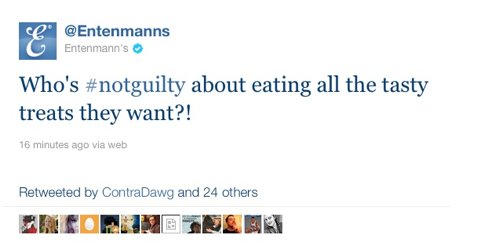
Innocent enough on its own, but since it happened to be the day jurors reached a verdict on Casey Anthony’s trial, many people found the tweet insensitive.
Not Leaving Room to MT
Twitter has a well-known retweet functionality, which sends out another user’s tweet to your followers. Less universally known but still popular is the “MT,” or modified tweet. MTs work like a retweet, but users can tack on their own commentary, attributing it back to the original tweeter by @mentioning their username.
The problem? That’s a lot to fit into 140 characters! Your tweet should be short enough that your followers have the room to MT, @mention you, and add their own comment.
Fortunately, science has given us an exact range to shoot for: 71 to 100 characters is said to be the optimal length for a tweet.
Not Understanding How Direct Messages Work
Direct messages, or DMs, are another tough feature for new users to grasp. DMs are more private than directly tweeting at someone by starting a tweet with a @mention, as they open up a private message only viewable by the users involved.
If you want someone to DM you back a piece of information (for example, send over their email address or phone number), under Twitter’s default settings, you need to be following each other first.
Not following someone you ask to DM you is just asking them to awkwardly tweet back at you that they can’t yet! To avoid this problem, just make sure you follow before you request a DM, or turn on the setting allowing anyone to DM you.
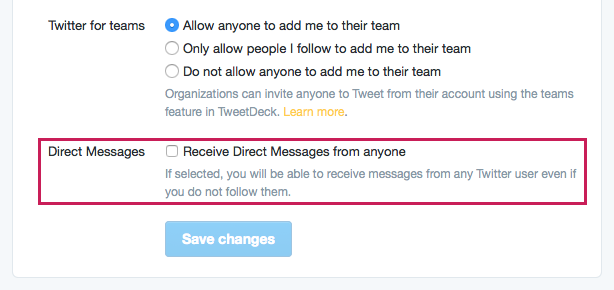
Not Cropping Images for Twitter
Like other social networks, Twitter crops the images you upload down to a uniform size before sharing them in your tweet.
Unfortunately, all social networks have slightly different sizing requirements for the images you share, which often means that you need to save a few variations of an image.
You can click to expand them, of course, but Twitter will always focus on the center of an image, cropping it to a 2:1 aspect ratio.
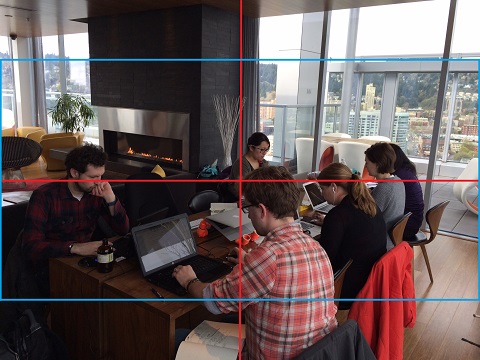
In many cases, this doesn’t matter too much, but it can lead to cut off heads or text if the center of your image isn’t quite the focus.
To avoid this problem, simply crop your images so that the focal point is in the center of the image.
Not Monitoring Your Brand
If someone mentions your brand, service, or product on Twitter, you want to be there to join in on the conversation. Maybe they are having a problem that you can helpfully provide a solution to. Or maybe they are recommending your product to your followers, in which case you’ll want to thank them and possibly even use the tweet as a testimonial. In either case, it’s best if you can be there.
Unfortunately, people don’t always remember to @mention you when they are talking about you, so you should always be monitoring for your brand name and product names.
TweetDeck, a free tool provided by Twitter, makes it easy to monitor whatever you want to keep an eye on, whether that’s @mentions, names of your products, or even hashtags you like to keep an eye on. For my blog, I monitor @mentions, my blog’s name, and the most popular hashtag in my niche.
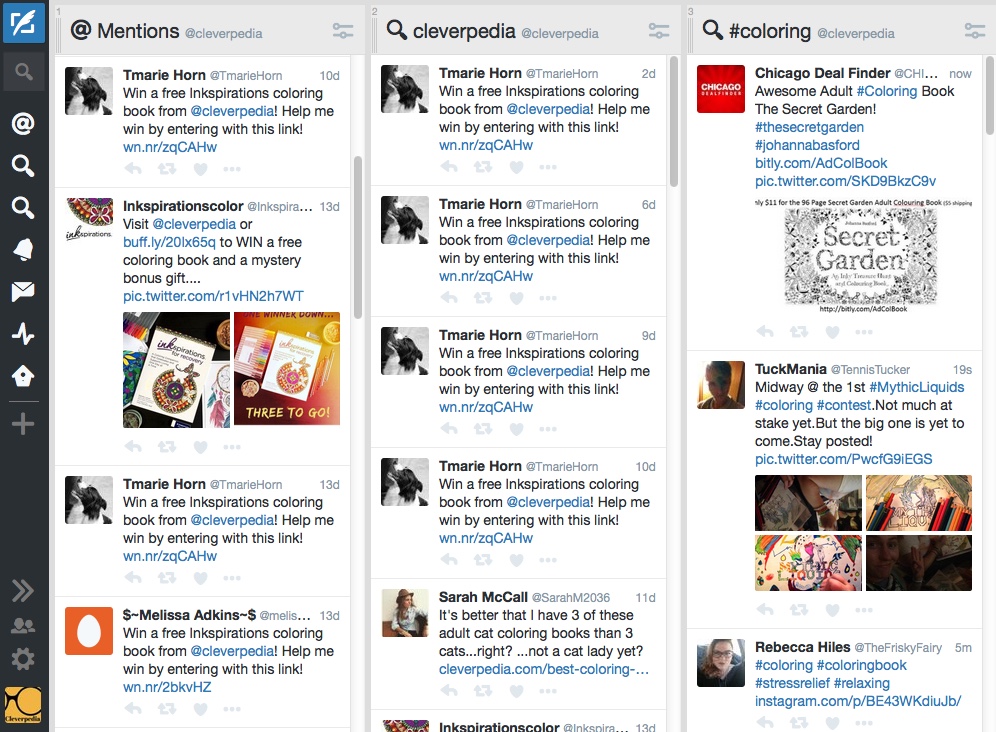
Not Tagging the People & Brands You Mention
Just because other users don’t necessarily @mention your business when they mention you in a tweet doesn’t mean you should do the same! It is a good practice to @mention the brands, businesses, or people who mention in your tweet, since it could potentially spread your tweet’s reach. The named person or brand may choose to respond, or even retweet it out to their own followers.
This is especially important to do if you are partnering up with another brand, mention another company’s product in a flattering way (never hurts to build those bridges!), or an influencer writes a post for your blog, since the @mentioned user almost always will retweet it.
Wrapping Up
If you correct these seven simple Twitter mistakes, you will catch the majority of the errors people make on Twitter. Your tweets will have broader reach for very little effort.
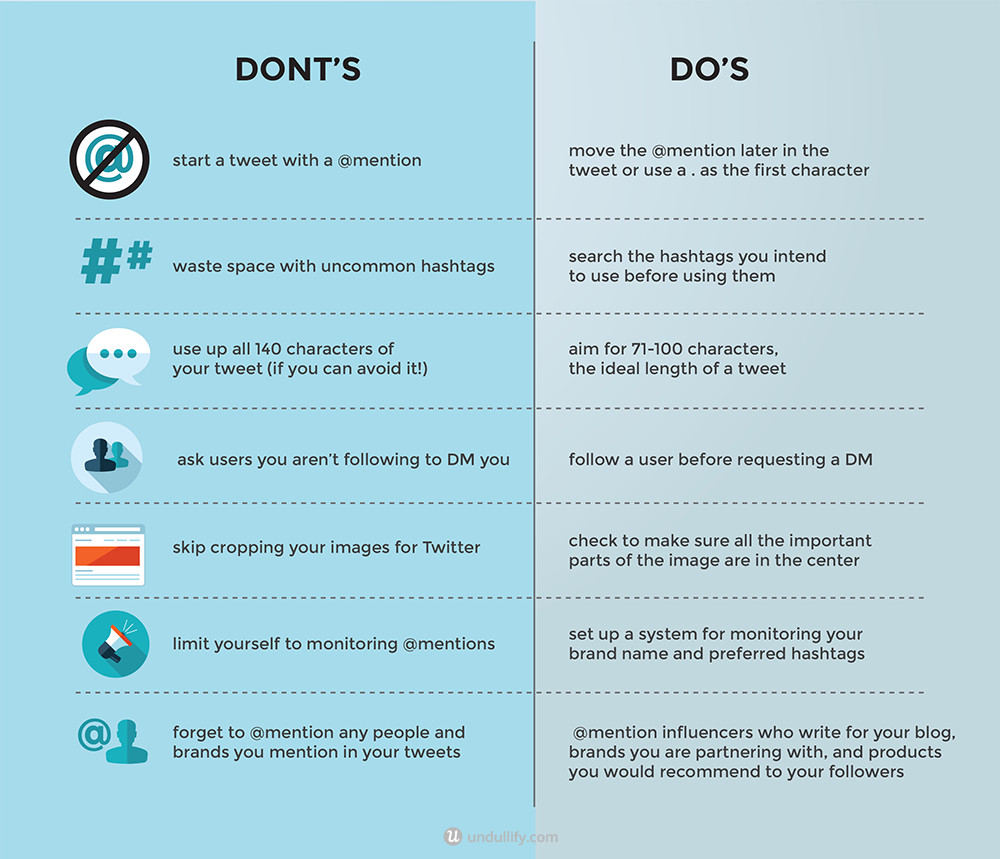
Here’s a quick do’s and don’ts checklist to make sure you catch these common mistakes:
- Don’t start a tweet with a @mention
- Do move the @mention later in the tweet or use a . as the first character
- Don’t waste space with uncommon hashtags
- Do search the hashtags you intend to use before using them
- Don’t use up all 140 characters of your tweet (if you can avoid it!)
- Do aim for 71-100 characters, the ideal length of a tweet
- Don’t ask users you aren’t following to DM you
- Do follow a user before requesting a DM
- Don’t skip cropping your images for Twitter
- Do check to make sure all the important parts of the image are in the center
- Don’t limit yourself to monitoring @mentions
- Do set up a system for monitoring your brand name and preferred hashtags
- Don’t forget to @mention any people and brands you mention in your tweets
- Do @mention influencers who write for your blog, brands you are partnering with, and products you would recommend to your followers
Know another mistake I missed? Please share it in the comments below!

